
by Sebastián Bianchi
The Spanish Cross (Spanienkreuz) was instituted on April 14th, 1939, to recognize those German Forces who served in the Spanish Civil War (July 1936- March 1939). The “Condor Legion” who fought on the side of General Franco against communism in Spain was composed, at least publicly, of volunteers. Because of their semi-official status no awards were instituted prior to or during the war, and therefore there was no method to recognize German bravery and accomplishment until 1939. The purpose of the Spanish Cross therefore was two fold; It was not only to be a campaign medal, but also an award recognizing achievements.

Knoerger next to Doenitz and an Italian Admiral. Under the Spanish Cross he is wearing another Spanish decoration, possibly the Cross of War; the position is incorrect, it should be on the left tunic pocket.
The Kondor Legion
The Legion Condor was compromised of over 25,000 troops who pioneered the now famous concepts of blitzkrieg in the field of Spain. In addition to the Spanish Republican Army, the Condor Legion and their allies would come up against Communist forces sent from Russia and "International Legions" (French, Canadian, U.S.). This aid began to arrive and supply the Republican side almost immediately after the War began.
The Condor Legion ranks were mostly composed of Luftwaffe personnel, who would further develop and test air war tactics and equipment later used with much success throughout World War II. They would participate in critical battles, such as the Aragon Offensive, the Battle of Ebro, and the final assault on Catalonia. They would also be involved in controversial civilian bombing, such as the bombing of the towns of Bilbo and Guernica in 1937. Overall, the War in Spain lasted three years, there were many hard fought battles and 600,000 total lives lost from all causes.
With German and Italian help, General Franco and the Nationalist forces
prevailed. Upon the return of the Condor Legion to the Reich, awards were
presented in ceremonies with much flair. On June 6th, 1939, all the recipients
paraded through the streets of Berlin in front of Hitler and a rapturous public.
|
|
| General Knoerger, Felkommandant de Bordeaux between 1942 and 1944, wears the Spanish Cross with Swords |
The Spanish Cross
The Spanish Cross was awarded in four classes, Bronze, Silver, Gold and Gold with Diamonds. The bronzed and silver classes came in two categories, with swords (combatant) and without swords (non-combatant), while the Gold and Gold with Diamonds classes were awarded only with swords.
The award took the shape of an eight pointed convex cross with a mobile
swastika in the center disk. The reverse was plain with only the manufacturer
mark (if present), and a wide pin and catch soldered to it, from which the Cross
was attached to the uniform. Privately purchased copies can be found
with the screwback variation, a fastening method that, as with the Iron Cross
1st Class, was preferred by those combat troops whose activities required
further security.
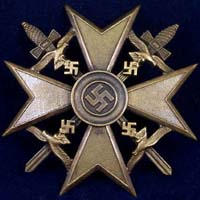 |
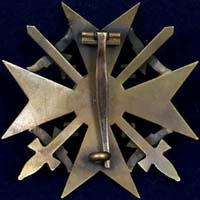 |
|
Spanish Cross in Bronze With Swords | |
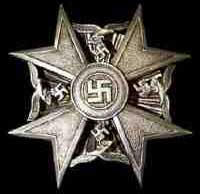 |
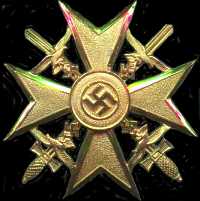 |
|
Spanish Cross in Silver |
Spanish Cross in Gold |
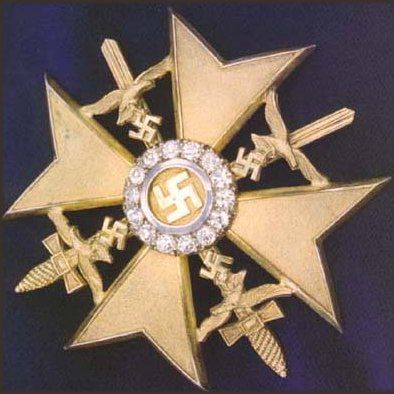
| Fitted between the arms of the cross were four Luftwaffe flying eagles carrying a swastika, a tribute to all the airmen who made up almost 70 percent of the Legion. The Spanish Cross in Bronze was die struck in tombak or bronzed brass and the Silver can be found both in hallmarked 800 grade silver and silver plated brass. The Spanish Cross in Gold was made of 800 silver with a mat gold plating and a beautiful highlighted finish. The thickness of each arm decreased from a wide center to a narrower tip. The eagles (pictured right) were made from a separate striking and were attached by having their wings soldered to the arms of the cross. In the combatant grade the swords were positioned between the arms of the Cross pointing upward. The Spanish Cross in Gold with Diamonds was exactly alike to the Gold Cross but were fitted with 14 brilliants surrounding the center swastika. | 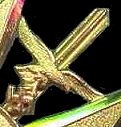
|
Award Criteria, Statistics and Wear
Eligible for the award were personnel from all military branches and civilians who volunteered and participated in the conflict. The criteria for the Cross without swords was three months of service on Spanish soil or waters. It was presented to Military personnel who did not experience any combat, which included auxiliary units such as Luftwaffe field units and medical units. There were 7869 Bronzed Crosses without Swords presented. Those non-combatants who distinguished themselves above and beyond the call of duty were presented with the Spanish Cross in Silver, and there were 327 Crosses of that grade awarded. There were no Spanish Crosses in Gold without Swords presented, whether or not they were manufactured is a debated topic.
To obtain the Cross with Swords an individual had to be involved in front line combat, and the degree of experience and rank determined whether the Cross was bestowed in Bronze, Silver or Gold. The lowest grade, Bronzed, required action with the enemy in any degree, and 8462 were presented.
The silver grade with Swords was normally reserved for those who had at least moderate combat experience, having participate in decisive battles. Of this grade 8304 were awarded.
The Gold Cross with Swords was restricted to those who not only engaged the enemy, but had also excelled in the form of personal bravery or achievement. There were 1,126 individuals who received this grade.
The highest grade, Gold with Diamonds, was strictly presented to those with the highest achievements or leadership in action. It was only awarded 28 times, with the majority going to Luftwaffe pilots. These aces of the time include Molders (14 kills), Oesau (8 kills), Balthasar (7 kills) and Lutzow (5 kills).
The Spanish Cross was worn permanently on the right pocket of the uniform tunic as shown in the original photo to the right, below the later instituted German Cross if that was held. When presented, each class had a different color case. Bronze Crosses came in a green case, Silver and Gold in a blue case, and Gold with Diamonds in a red case. A document authorizing the award was also presented.
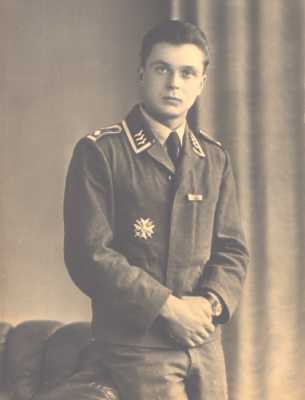
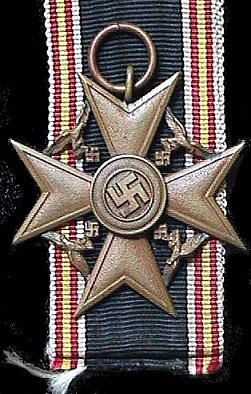 |
This award was established the same day as the Spanish Cross to commemorate those legionaries who fell during the Spanish conflict. The award was a smaller version of the Spanish Cross with swords and it was produced from bronze or brass with a bronze wash. As with the Spanish Cross, the reverse was plain. It was held by a black ribbon with the colors of the Spanish flag (red-yellow-red) on its edges. The award was presented to the next of kin in cases of soldiers killed or missing in action or if death occurred due to war related sickness. A total of 315 Honor Crosses were awarded. |
![]()
© Copyright Wehrmacht-Awards.com LLC |
